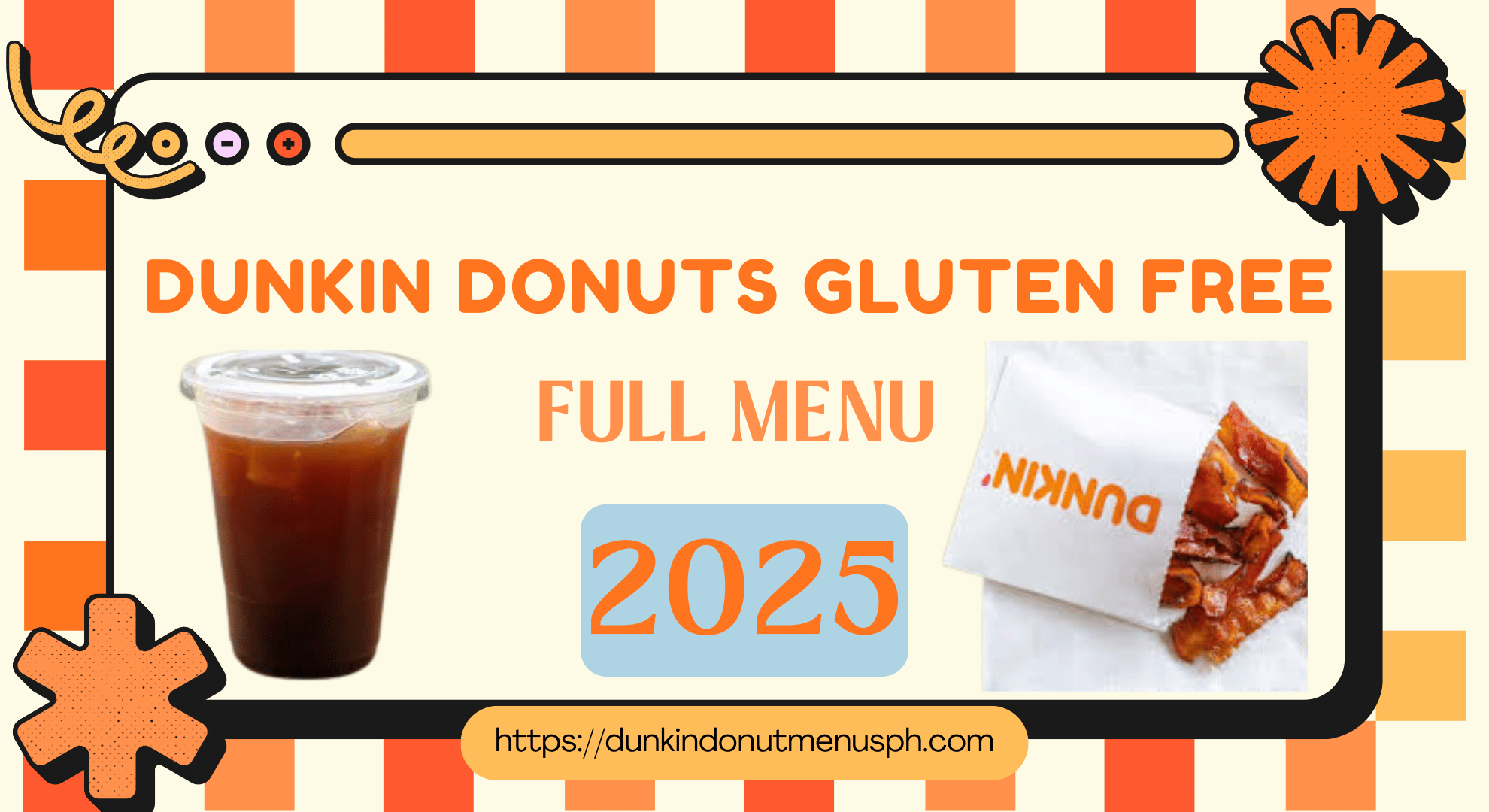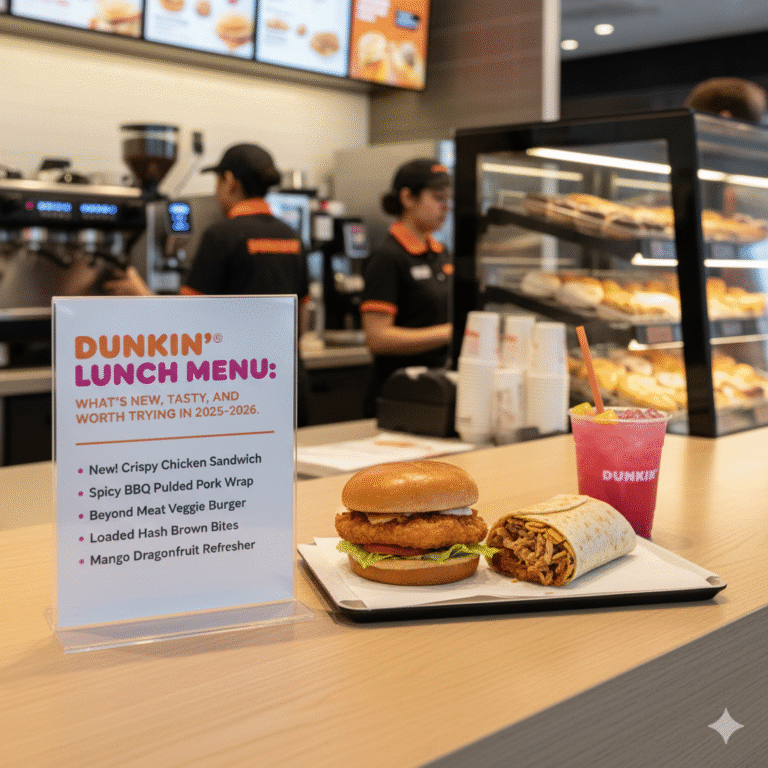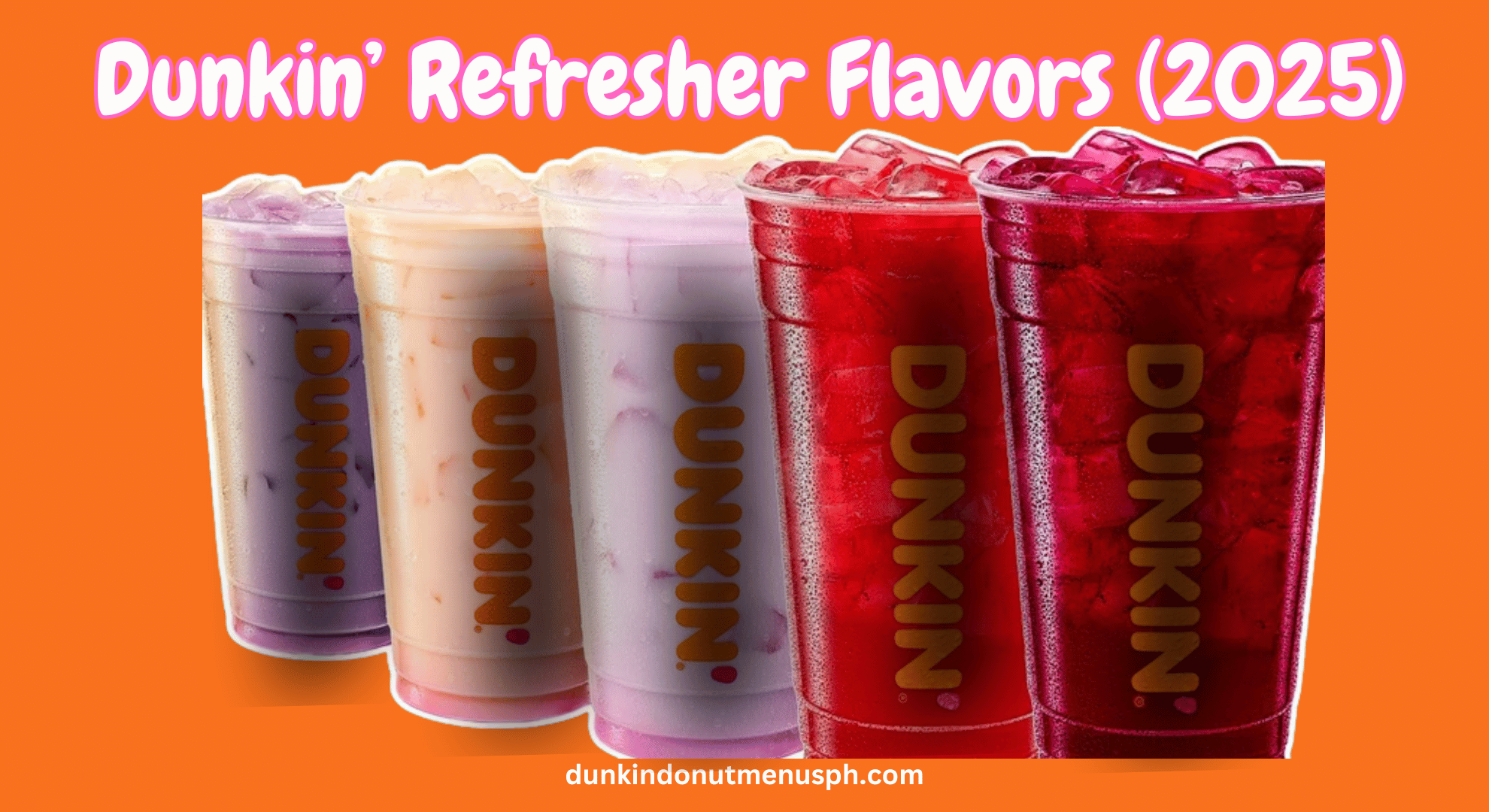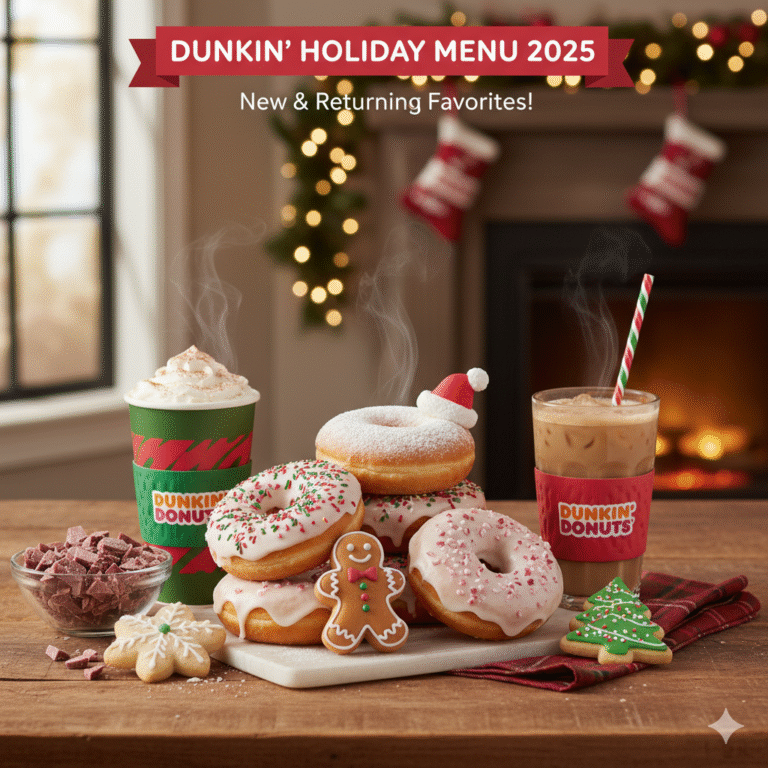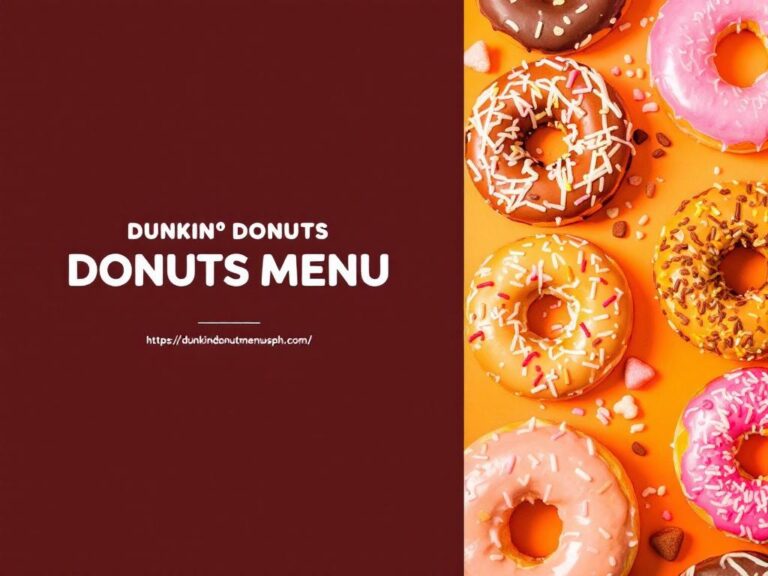Dunkin Donuts Gluten Free Menu 2025
Over the last 10 years, working with bakeries that wanted to introduce gluten‑free options (without ruining their brand or their bottom line), I’ve learned exactly how a gluten‑free donut menu can be built, vetted, and marketed so it feels as indulgent and trustworthy as a regular donut menu.
In this article, I promise you a complete menu outline for gluten‑free donuts (and companion items), tips from someone who’s been behind the scenes, and realistic caveats you should communicate. If you ever want to launch or refine a gluten‑free donut menu — or just know what to look for when ordering — this will be your go‑to guide.
Let’s get started with what a truly safe, enjoyable Donuts Gluten Free Menu: Complete Menu might look like.
What “gluten‑free donut” really means
Before we list out flavors and items, we need to agree on what qualifies as a gluten‑free donut — and what risks you must address.
- Intended for: All variants of wheat, barley, or rye and its derivatives are excluded. Instead, they will probably use rice flour, sorghum, tapioca, millet, and potato flours, perhaps in combinations with starches and binding agents such as xanthan gum, guar gum, psyllium, etc.
- Dedicated Equipment or Fryer: One of the biggest risks is cross contamination. If your regular donuts are fried in oil or baked in an oven used for gluten products, traces of gluten may persist. I’ve advised bakeries to install a separate fryer or bake schedule.
- Testing & Certification: Many serious gluten-free bakeries seek third-party certifications (GFCO, or local equivalent) in order to instill confidence in the minds of consumers.
- Labeling & Transparency: Every flavor or item on the menu must clearly state “gluten-free” and if appropriate, “Prepared in a dedicated facility/fryer”.
When these foundations are solid, then the fun part starts: building the menu.
Core Donut Styles for a Gluten‑Free Menu
In a complete gluten‑free donuts menu, you’ll want to cover the major styles so you satisfy different cravings. Here’s what I often advise to include:
1. Gluten‑Free Cake Donuts
These are denser, richer, and reminiscent of classic old-fashioned or cake donuts. They tend to hold form well when gluten-free.
Flavor ideas:
- Plain / Sugar coated
- Chocolate glazed
- Buttermilk glazed
- Cinnamon sugar
- Maple frosting
- Pistachio glaze or nut drizzle
- Seasonal flavors (pumpkin spice, apple cider)
I’ve tested versions that rival traditional cake donuts in texture — when the flour blends, moisture, and binder are balanced just right.
2. Gluten‑Free Yeast / Raised Donuts (Optional/difficult)
These are trickier in a gluten-free world because gluten gives elasticity and structure. Some bakeries attempt soft raised gluten‑free donuts by blending gums, eggs, or enzyme aids; but the risk of collapse or dryness is higher.
If including these, you should label them as “gluten‑free raised style (soft)” and test heavily.
3. Filled & Stuffed Gluten‑Free Donuts
Once your base donut works, fillings add theatre. Examples:
- Jam-filled (strawberry, raspberry)
- Custard or crème filling
- Nutella or chocolate ganache
- Apple pie style (cinnamon-apple compote inside)
Mind the fillings themselves — they too must be gluten-safe and free of hidden wheat thickeners.
4. Specialty & Hybrid Donuts
These give your menu a “signature” edge:
- Mochi donuts (some are gluten-free — made using sweet rice/tapioca flour)
- Donut “holes / munchkins” made gluten-free
- Mini donuts — easier to handle, for sampling
- Donut sandwiches using gluten-free brioche buns (for savory items)
Including one or two “wow” items gives customers something to talk about.
Dunkin Donuts Gluten-free Menu
The following is the gluten free menu you can get
Dunkin’ Donuts Gluten-Free Donuts & Munchkins
| Menu Item | Gluten-Free | Price |
|---|---|---|
| Munchkins® Donut Hole Treats | ❌ | $2.49 (10 pcs) |
| Donuts (All Varieties) | ❌ | $1.39 each |
Dunkin’ Espresso & Coffee (Gluten-Free Options)
| Menu Item | Gluten-Free | Price (Small) |
|---|---|---|
| Espresso | ✅ | $1.99 |
| Americano (Hot/Iced) | ✅ | $2.39 |
| Coffee (Hot/Iced) | ✅ | $2.09 |
| Cold Brew | ✅ | $2.79 |
| Iced Coffee | ✅ | $2.49 |
| Cappuccino (Hot/Iced) | ❌ | $3.59 |
| Latte (Hot/Iced) | ❌ | $3.79 |
| Signature Latte (Hot/Iced) | ❌ | $4.29 |
| Macchiato (Hot/Iced) | ❌ | $3.89 |
Dunkin’ Tea & More (Gluten-Free Options)
| Menu Item | Gluten-Free | Price (Small) |
|---|---|---|
| Iced Tea | ✅ | $2.09 |
| Hot Tea | ✅ | $2.09 |
| Dunkin’ Refreshers | ✅ | $2.79 |
| Sparkd’ Energy Drink | ✅ | $2.99 |
| Matcha Latte (Hot/Iced) | ❌ | $3.59 |
| Chai Latte (Hot/Iced) | ❌ | $3.59 |
| Hot Chocolate | ❌ | $2.29 |
Dunkin’ Frozen Drinks (Gluten-Free Options)
| Menu Item | Gluten-Free | Price (Small) |
|---|---|---|
| Frozen Coffee | ✅ | $3.99 |
| Coolatta (All Flavors) | ✅ | $3.99 |
| Frozen Chocolate | ❌ | $3.99 |
| Frozen Matcha Latte | ❌ | $4.29 |
Dunkin’ Snacks & Wraps (Gluten-Free Options)
| Menu Item | Gluten-Free | Price |
|---|---|---|
| Snackin’ Bacon | ✅ | $3.29 |
| Hash Browns | ✅ | $1.89 |
| Wake-Up Wraps (All Varieties) | ❌ | $2.09 |
| Stuffed Bagel Minis | ❌ | $2.99 |
Dunkin’ Sandwiches & Breakfast (Gluten-Free Options)
| Menu Item | Gluten-Free | Price |
|---|---|---|
| Bacon, Egg & Cheese | ❌ | $3.99 |
| Sausage, Egg & Cheese | ❌ | $3.99 |
| Turkey Sausage, Egg & Cheese | ❌ | $3.99 |
| Sourdough Breakfast Sandwich | ❌ | $4.29 |
| Egg & Cheese | ❌ | $2.99 |
Dunkin’ Muffins & Bagels (Gluten-Free Options)
| Menu Item | Gluten-Free | Price |
|---|---|---|
| Muffins (All Varieties) | ❌ | $1.89 |
| Croissant | ❌ | $1.79 |
| English Muffin | ❌ | $1.59 |
| Bagels with Cream Cheese | ❌ | $2.19 |
Dunkin’ Brew at Home (Gluten-Free Options)
| Menu Item | Gluten-Free | Price |
|---|---|---|
| Packaged Tea | ✅ | $5.99 (box) |
| Packaged Coffee (Ground or Whole Bean) | ✅ | $9.99 (12 oz bag) |
| K-Cup® Pods | ✅ | $11.99 (10-count) |
Dunkin’ Flavor Shots & Swirls (Gluten-Free Options)
| Flavor | Gluten-Free | Extra Cost |
|---|---|---|
| French Vanilla Swirl | ✅ | +$0.50 |
| Mocha Swirl | ✅ | +$0.50 |
| Butter Pecan Swirl | ✅ | +$0.50 |
| Hazelnut Swirl | ✅ | +$0.50 |
| Caramel Swirl | ✅ | +$0.50 |
| Cookie Dough Swirl | ✅ | +$0.50 |
When I helped one bakery in my city transition their entire weekend line to gluten-free, these types of flavors became their top sellers (the blueberry-cream filled and cinnamon sugar were fast movers).
Marketing tips & menu presentation (from 10 years of experience)
Having a delicious gluten-free donut line is one thing — getting people to trust and buy it is another. Here are lessons I’ve learned:
- Tell the story – On the menu, mention “dedicated gluten‑free fryer,” “certified,” or “no wheat used.” This builds trust.
- Small batch for quality – Don’t overextend. Start with just a few flavors so you can monitor quality and avoid waste.
- Visible process – If possible, allow customers to see part of the process (or show photos) of how the donuts are made in a separate zone. That reassures skeptics.
- Offer combos – Pair a donut with a GF coffee or tea, or offer a “gluten-free donut flight” (sample 4 mini donuts for a fixed price).
- Rotate seasonally – Keep the menu fresh. For instance, a pumpkin spice donut in fall, or citrus glaze in spring.
- Train staff – Every employee must know your cross-contamination protocols. A few years ago, I visited a shop whose “gluten-free” donuts were stored on the same rack as regular ones — disastrous from a safety and brand perspective.
- Gather feedback & iterate – Ask your gluten-free customers often what they’d like to see. Over time, you’ll discover your hit flavors and drop underperformers.
Ordering advice for gluten‑free customers (what to watch for)
As someone who’s both developed menus and eaten enough gluten-free donuts to spot issues, here’s how I advise customers to evaluate a Donuts Gluten Free Menu: Complete Menu when ordering:
- Ask about the fryer or oven: Is it dedicated? Shared? If shared, cross-contamination risk is higher.
- Check ingredient lists: Especially for glazes, fillings, or toppings — sometimes malt extract, modified starch from wheat, or barley derivatives sneak in.
- Request freshest batch: Many gluten-free donuts dry out faster. Ask if they can bring one straight from the fryer or oven.
- Avoid overly heavy glazes: Excess moisture plus gluten-free structure can make them soggy.
- Handle toppings carefully: Crushed cookies, cookies & cream bits, or sprinkles might be processed with gluten—ask if those are gluten-safe.
- Test “simple” first: Try a plain or sugar donut before going for elaborate ones, to see how well their base recipe is.
In my experience, one bakery that launched a “gluten-free full assortment” had a big spike in returns until they adjusted their handling of toppings and improved airflow so donuts didn’t sweat and collapse. Once they fixed that, negative feedback dropped to near zero.
Dunkin Donuts Gluten Free Menu PDF
Real‑world examples & case studies
It helps to see what actual gluten-free donut menus or shops are doing. Here are a few examples I’ve followed over the years:
- Donut I Love U (California): Their entire donut line is gluten-free, including toppings and glazes. They offer flavors like Ore Uh Oh! (crushed gluten-free Oreo, chocolate sauce), Strawberries & Cream, Very Berry Delicious, American Pie (apple compote) and more.
- Gluten Free Donuts (Australia): They offer flavors such as cinnamon, Nutella, caramel, custard, lemon cream, etc., all gluten-free.
- New Cascadia Traditional (Portland bakery): They run a fully gluten-free bakery and include donuts (maple bars, etc.) on their menu alongside breads, cinnamon rolls, etc.
- Dunkin’ Donuts: While not offering gluten-free donuts in general, they do offer gluten‑free beverages and snacks (hash browns, etc.) — a contrast worth noting.
- Krispy Kreme: They openly state they have no gluten-free donut options, only beverages in some lines.
From these, you see two paths: a bakery fully committed to gluten freedom, or a conventional donut shop offering a limited gluten-free side line. Both are valid — but the customer perception and operations differ.
Conclusion & call to action
Designing a Donuts Gluten Free Menu: Complete Menu is both an art and a science. Over my 10 years, I’ve seen how careful ingredient selection, strict contamination controls, smart flavor curation, and transparent marketing can transform a niche offering into a beloved product line. When done right, your gluten-free donuts don’t feel like a “diet version” — they feel like a reason to celebrate.
If you’re considering launching or refining a gluten‑free donut menu, I’d encourage you to start small, test intensely, and listen to feedback from your gluten-sensitive customers. The payoff is loyal customers who trust you — and spread the word.
If you’d like help designing a menu for your specific market (city, cultural flavors, ingredient availability), I’d be happy to assist. Just let me know your location and ingredient constraints, and I can help you build a gluten‑free donut menu tailored to your audience.
FAQs
Q1: Are gluten‑free donuts always healthier?
Not necessarily. Gluten-free donuts can still be high in sugar and fat. The “gluten-free” label only addresses wheat/gluten. Always check calories, ingredient quality, and portion size.
Q2: Can donuts made with rice flour or tapioca really mimic a wheat donut?
They can come close, depending on the mix, binders, hydration, and frying technique. Some texture and crumb differences are inevitable, but many gluten-free donuts delight people who haven’t had a decent donut in years.
Q3: How long do gluten‑free donuts stay fresh?
Typically shorter than conventional ones — often best consumed within the same day. Use packaging that retains moisture without making them soggy (e.g. vented boxes). If shipping, use insulated packaging and communicate thawing instructions.

